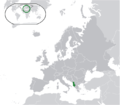Difference between revisions of "Albania Energy Situation"
***** (***** | *****) m |
***** (***** | *****) m (→Introduction) |
||
| Line 12: | Line 12: | ||
About 60% of Albanian energy demand is met through the fossil fuels. In terms of electricity generation, about 90% of the electricity is generated from hydropower. With the ongoing climate change, energy security could become a critical concern in Albania.<ref>Albania Energy Sector. Retrieved from :http://bit.ly/1xE4dar </ref> | About 60% of Albanian energy demand is met through the fossil fuels. In terms of electricity generation, about 90% of the electricity is generated from hydropower. With the ongoing climate change, energy security could become a critical concern in Albania.<ref>Albania Energy Sector. Retrieved from :http://bit.ly/1xE4dar </ref> | ||
| + | |||
| + | |||
| + | = Energy Situation = | ||
| + | |||
| + | |||
| + | = Renewable Energy = | ||
| + | |||
| + | |||
| + | = Fossil Fuel = | ||
| + | |||
| + | |||
| + | = Key Problems of the Energy Sector = | ||
| + | |||
| + | |||
| + | = Policy Framework, Laws and Regulations = | ||
| + | |||
| + | |||
| + | = Institutional Set up in the Energy Sector = | ||
Revision as of 15:43, 19 November 2015
Capital:
Tirana
Region:
Coordinates:
41.0000° N, 20.0000° E
Total Area (km²): It includes a country's total area, including areas under inland bodies of water and some coastal waterways.
28,750
Population: It is based on the de facto definition of population, which counts all residents regardless of legal status or citizenship--except for refugees not permanently settled in the country of asylum, who are generally considered part of the population of their country of origin.
2,777,689 (2022)
Rural Population (% of total population): It refers to people living in rural areas as defined by national statistical offices. It is calculated as the difference between total population and urban population.
36 (2022)
GDP (current US$): It is the sum of gross value added by all resident producers in the economy plus any product taxes and minus any subsidies not included in the value of the products. It is calculated without making deductions for depreciation of fabricated assets or for depletion and degradation of natural resources.
18,916,378,861 (2022)
GDP Per Capita (current US$): It is gross domestic product divided by midyear population
6,810.11 (2022)
Access to Electricity (% of population): It is the percentage of population with access to electricity.
100.00 (2021)
Energy Imports Net (% of energy use): It is estimated as energy use less production, both measured in oil equivalents. A negative value indicates that the country is a net exporter. Energy use refers to use of primary energy before transformation to other end-use fuels, which is equal to indigenous production plus imports and stock changes, minus exports and fuels supplied to ships and aircraft engaged in international transport.
13.80 (2014)
Fossil Fuel Energy Consumption (% of total): It comprises coal, oil, petroleum, and natural gas products.
61.42 (2014)
Introduction
Albania is a country in Southeastern Europe, bordered by Montenegro to the northwest, Kosovo to the northeast, Macedonia to the east, and Greece to the south and southeast.[1]
About 60% of Albanian energy demand is met through the fossil fuels. In terms of electricity generation, about 90% of the electricity is generated from hydropower. With the ongoing climate change, energy security could become a critical concern in Albania.[2]
Energy Situation
Renewable Energy
Fossil Fuel
Key Problems of the Energy Sector
Policy Framework, Laws and Regulations
Institutional Set up in the Energy Sector
Further Information
Reference
<references>
- ↑ http://en.openei.org/wiki/Albania
- ↑ Albania Energy Sector. Retrieved from :http://bit.ly/1xE4dar





















